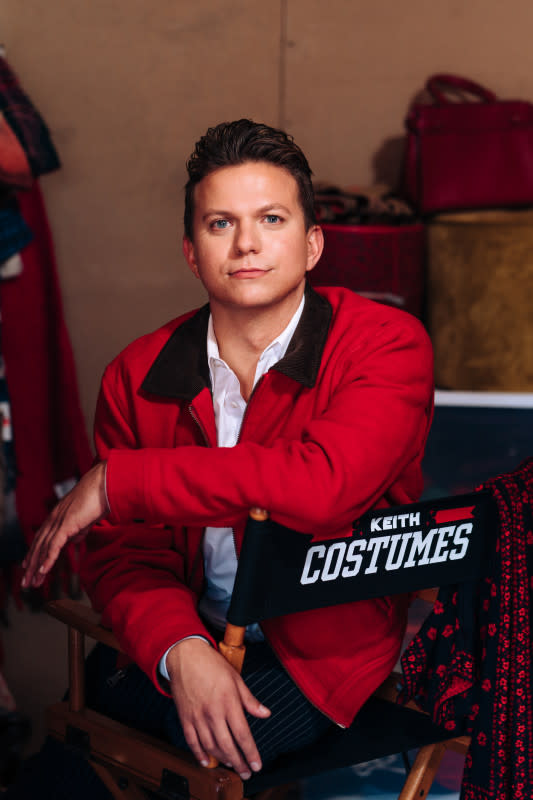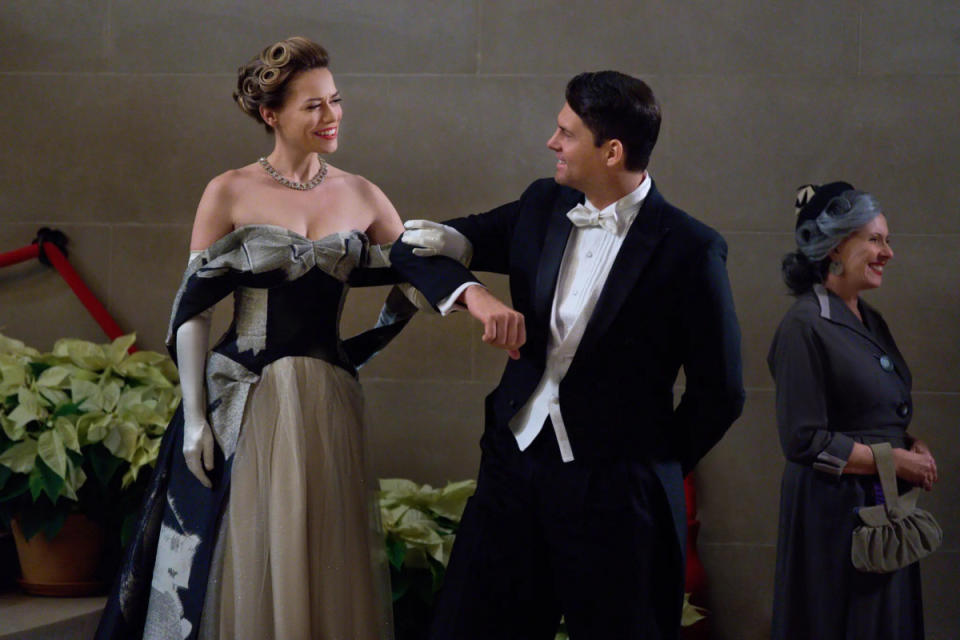How Hallmark's Costume Designer Creates Holiday Movie Magic
The promotional poster for "A Biltmore Christmas" isn't quite what one might expect from a Hallmark Channel holiday film. With nary a swatch of red or green in sight, the featured art showcases actors Bethany Joy Lenz and Kristoffer Polaha in authentic, 1947-era formalwear, promising viewers a straight-to-streaming Christmas movie that, well, looks anything but. Such is Keith Nielsen's plan, at least.
So far, Nielsen has overseen the costumes for seven Hallmark holiday movies, four of which will premiere this year. And though his costuming may not involve the genre's now-notorious signatures of misshapen turtlenecks and well-worn peacoats, he's still committed to capturing, and elevating, the essence of the season.
"I'm really proud of the fact that my movies aren't so cookie-cutter," he says. "I love that I'm still able to convey warmth and coziness, but just in a different way."
Having cut his teeth in the costume departments for shows like "Mozart in the Jungle" and "Quantico," Nielsen broke into the Christmas category with "My Adventures With Santa," a 2019 TV movie starring Denise Richards. His first Hallmark project, a 2011-set time-traveling story called "Next Stop, Christmas," aired in 2021, and he hasn't slowed down since.
Though several of his films, like "A Biltmore Christmas" and "Next Stop, Christmas," were at least partially set in years' or decades' past, Nielsen is keenly aware of the fact that these projects will air again and again as reruns for years (and holiday seasons) to come. If only from this perspective, his work is cut out for him: How can one present costumes that, against all odds, don't age?

Photo: Courtesy of Hallmark Channel
"Honestly, the one thing that's really ebbed and flowed for me, trend-wise, is the fit of jeans," he says. "We were into skinny jeans, and now I feel like we're out of that. But I'm also not pushing them to be too trendy, like the 'mom jean.'"
Of late, Nielsen has landed on a happy compromise in his films by way of the classic Levi's Slim Straight, which ticks all the contemporary boxes without explicitly pinning itself to any one style. Jeans, he explains, are a fitting case study for his Hallmark costuming as a whole: "Hallmark, to me, is a very American brand," he says; that fundamental understanding leads him to shopping off the rack at all-American retailers like Brooks Brothers, J.Crew and Banana Republic.
Not every piece you'll spot in a Hallmark holiday movie, however, comes straight from your (and perhaps your mother's) favorite mall brand. When starting a new film, Nielsen's first stop tends to be Oscar-winning costume doyenne Ann Roth's personal collection, the vast expanse of which is housed in a sprawling warehouse in Pennsylvania. Inside, Nielsen says, are aisles and aisles of clothes from her seven-decade long career across both Hollywood and Broadway.
"It's all stuff that's been made at awesome costume shops, or is vintage bought from all over the world," he says. "I usually start there, gathering things for anybody and everybody, including background actors."
Like Roth (who herself most recently landed a cameo in this summer's "Barbie"), Nielsen is no stranger to capital-F fashion: His process also includes scouring luxury consignment platforms, like The RealReal, for high-wattage garments that he employs strategically during crucial scenes. This year, those resale finds include a slew of vintage coats for another of his 2023 movies ("A Merry Scottish Christmas," starring "Mean Girls"' Lacey Chabert), as well as the glitzy gold gown featured on the aforementioned "A Biltmore Christmas" poster.
View the original article to see embedded media.
"A Biltmore Christmas," in particular, serves as the most hotly-anticipated of Nielsen's foursome of 2023 Hallmark spectaculars, and for good reason: It was shot entirely on location at the historic Biltmore Estate in Asheville, North Carolina, which remains one of the most prominent examples of Gilded Age mansions still standing today.
For Nielsen, such an iconic and lavish set demanded a meticulous attention to costuming detail. And with the lion's share of the film taking place in 1947, Nielsen was doubly tasked with prioritizing historical accuracy, which he garnered from 1940s-era advertisements and sewing patterns. The costumes' overarching color palette, consisting largely of jewel tones, is considered on the mark for the time period, too, also complementing the rich oaks and walnuts of the Estate's interior.
"I'm not just figuring out the costumes from head to toe," he says. "I'm always talking to my actors about thinking about the frame. You have to think about a costume in terms of the edit. You make or break a film in the editing room."
With Hallmark, Nielsen is used to working quickly, often having no more than a week or two of prep time before filming begins. On "A Biltmore Christmas," he was fitting actors — including close to a thousand extras — on a Saturday before they shot on a Monday. His department, he says, demands diligent organization: After clothing has been ordered by type and style, Nielsen and his support team of seven assign each outfit a garment bag that comes adorned with a tag, labeling all its scenes; each is filled with everything from jewelry to shoes, and gets brought into actors' trailers. At the end of the day, everything goes back in the bag, and off it goes to get laundered.

Photo: Courtesy of Hallmark Channel
Nielsen's garment-bag practice is as advantageous for function as it is for form. He'll often line up a character's full breadth of garment bags to see their color story from first shot to last. In the warm-and-fuzzy Hallmark holiday universe, Nielsen can say a lot with color.
"I like to do a little color connection thing, where I tie [the color of a woman's coat] into [her romantic interest's] tie or sweater," he says. "The home movies are only an hour and a half, so choices need to be a little obvious sometimes. And we do know what's going to happen, so I like to lean into that."
Predictable? Maybe so. But this doesn't mean that Nielsen's Hallmark projects aren't also legitimate in their own right — artistically and otherwise. Since his first Christmas movie aired in 2019, he's found there to be a growing credibility in the oft-dismissed genre, if only from those industry folks behind the scenes. This year, three out of four his Hallmark films were full union productions — and they're getting bigger, he says.
During the holiday season, more than 80 million people watch at least a few minutes of a Hallmark movie, according to global consumer research firm Nielsen (of no relation to the costume designer). Most weeks in November and December, the company has found that Hallmark ranks as the number-one network among the advertiser-friendly demographics of women 18-49 and 25-54. It's also a huge boon for advertisers, which help generate more than $350 million for Hallmark just from its Christmas movies alone.
"I can travel anywhere and find that somebody has seen my work," says Nielsen. "But these movies bring a lot of joy to a lot of people, including those who are homebound or going through hard times. This is what they look forward to all year, and I'm a part of that joy."
Never miss the latest fashion industry news. Sign up for the Fashionista daily newsletter.

